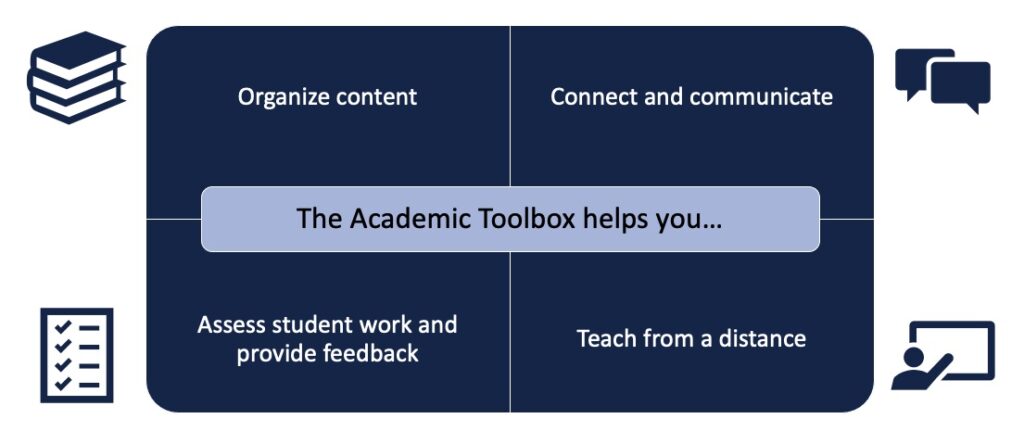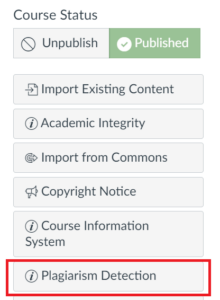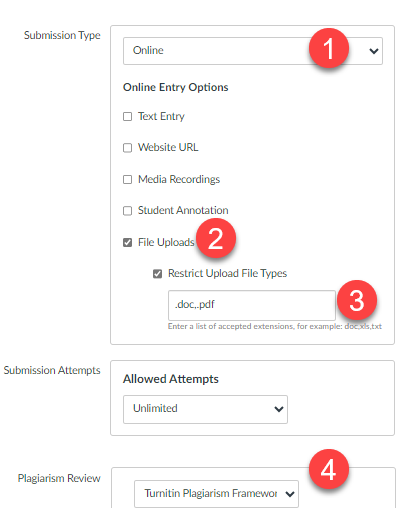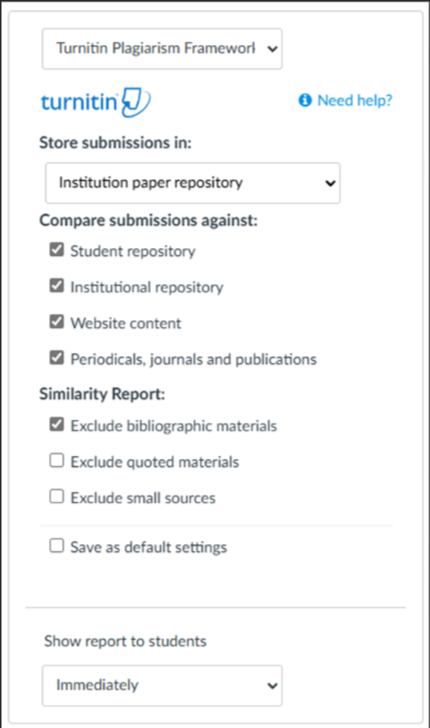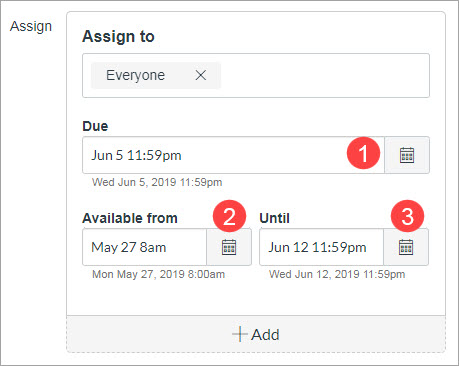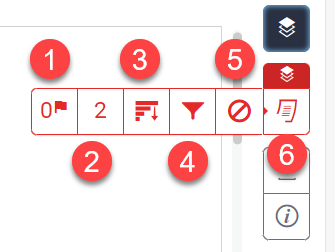Plagiarism Review – Turnitin

The University’s Plagiarism Detection Tool is an electronic resource that assists with detecting textual similarities between compared works. Instructors must exercise their independent professional judgment in looking at the Similarity Report and determining whether a text has been plagiarized.
Note: The Plagiarism Detection Tool is an integrated tool in Quercus. Using the Turnitin website directly is not supported at U of T.
Instructors must adhere to the University of Toronto Plagiarism Detection Tool Conditions of Use and inform their students at the start of the course that Plagiarism Detection will be used for coursework. Instructors must include the Conditions of Use statement in their course syllabus. Consult the Plagiarism Detection resource for information (uoft.me/pdt).
Due Dates: Turnitin reports will be regenerated on the Assignment due date to check for collusion. Reports and scores may change after the due date.
If you have done a “Course Copy” from a Summer 2024 course or earlier: you will need to edit your assignments and change them to “Turnitin Plagiarism Framework”.
The Academic Toolbox helps you...
The tools in your Quercus Academic Toolbox can assist with your course delivery by Organizing Content, helping you Connect and communicate with your students, Assessing student work and providing feedback, and allowing you to Teach from a distance.
Typical Course Format?
Most tools in the Academic Toolbox can assist in both online and face-to-face courses. Many tools can provide benefits in either synchronous or asynchronous teaching. Some tools have been primarily designed for one format or another (synchronous/asynchronous), however, may be adapted for any format depending on your pedagogical goals.
To learn more about different teaching modalities, please consult our Online Teaching & Learning page, arrange a consultation with a CTSI Teaching Liason, or contact your Divisional support representative.
Where can I get more support?
Related resources / similar tools
How to Get Started
When creating or editing an assignment in Quercus, choose “Online” and “File Uploads” as the Submission Type, and then choose “Turnitin Plagiarism Framework” in the Plagiarism Review section:
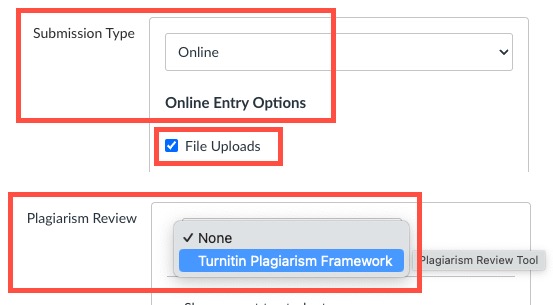
Instructions
-
Conditions of Use at the University of Toronto
The Plagiarism Detection Tool Conditions of Use statement is available in Quercus courses for instructors to copy and paste in the course syllabus.
On the Quercus course home page, navigate to the right-hand sidebar menu (under Course Status) and click on the Plagiarism Detection button:

The Conditions of Use are also listed below:
CONDITIONS OF USE AT THE UNIVERSITY OF TORONTO
The use of University’s plagiarism detection tool by our instructors is completely voluntary. Those wishing to use the University’s plagiarism detection tool in their courses must adhere to the following conditions of use:- University’s plagiarism detection tool is a tool that will assist in detecting textual similarities between compared works. Instructors must exercise their independent professional judgment in, and assume responsibility for, determining whether a text has been plagiarized or not.
- Instructors must include the following passage (as is) on the course outline at the start of the class. Please note that the statement cannot be altered in any way.
“Normally, students will be required to submit their course essays to the University’s plagiarism detection tool for a review of textual similarity and detection of possible plagiarism. In doing so, students will allow their essays to be included as source documents in the tool’s reference database, where they will be used solely for the purpose of detecting plagiarism. The terms that apply to the University’s use of this tool are described on the Centre for Teaching Support & Innovation web site (https://uoft.me/pdt-faq)”. - Students are permitted, under our conditions of use, to opt-out of using the University’s plagiarism detection tool. If a student chooses not to submit their assignment through the University’s plagiarism detection tool, instructors will need to find alternative arrangements to check their work as rigorously. (It should be noted that very few students choose to opt out.) Students cannot be penalized for choosing to opt out. If students choose to opt out, they should let their instructor know well in advance of submitting their paper. Ideally, they should communicate this during the first class, when the instructor is reviewing the course outline. In this case, you may ask them to submit all of their rough work for an assignment or you may have a short meeting with them and ask pointed questions about their research methodology. Instructors should not be asking students to do anything that might be perceived as additional work. We ask that instructors consult with the Centre for Teaching Support & Innovation when establishing these alternatives.
For information on alternative methods to submitting to Plagiarism Detection see this page from the Centre for Teaching Support and Innovation (CTSI).
Note: The Plagiarism Detection Tool is an integrated tool in Quercus. Using the Turnitin website directly is not supported at U of T.
-
Navigate to Assignments in the course menu and Click the blue +Assignment button to create a new assignment. Add the assignment title and directions. Then edit the assignment details as follows:
- From the Submission Type drop-down menu, select Online
- Under Online Entry Options, select File Uploads. File Upload is recommended for assignment submissions.
- Select Restrict Upload File Types to restrict submissions to specific file types. Enter a list of accepted extensions, separated by commas (see Plagiarism Detection File Types and Sizes)
- From the Plagiarism Review drop-down menu, select Turnitin Plagiarism Framework.

-
Customize Plagiarism Detection Settings
Select Plagiarism Review settings to suit your assignment.
For best results, use the following settings:
- Store submissions in: Select Institution paper repository from the drop-down menu. This option ensures that the student submissions for your assignment are stored in U of T’s paper repository for comparison with future student papers.
Do not store the submitted papers means that after the similarity check has been performed on the submission, the file will not be stored in U of T’s paper repository.
The Standard paper repository is not available at U of T.
- Compare submissions against: Ensure all four options have been checked.
- Similarity Report: Select “Exclude bibliographic material”. This can help to reduce the rate of false positives. Note: This should not be selected if the Assignment is an annotated bibliography or another paper type with a non-typical reference section.
- Save Turnitin settings: Select Save as default settings to make these selections the default settings for future Turnitin assignments in the course.
- Show report to students: Choose whether students can view their Similarity Report by selecting one of four options:
- Immediately: Students can view the report on submission (as soon as it is generated by Turnitin)
- After the assignment is graded: Students can view the report as soon as it has been graded in Quercus.
- After the due date: Students can view the report as soon as the assignment due date passes.
- Never: Students cannot view the report at any time. Instructors will be able to see the report after students submit the assignment.

More details about Settings is available at Assignment Management.
Note: In the former Plagiarism Detection Tool, Ouriginal, submissions for an assignment could be marked a anonymous. This option is not available from the Quercus-integration Turnitin interface. - Store submissions in: Select Institution paper repository from the drop-down menu. This option ensures that the student submissions for your assignment are stored in U of T’s paper repository for comparison with future student papers.
-
Grade Posting Policy and Plagiarism Detection Similarity Reports
With the new Grade Posting Policy for the Gradebook, Similarity Reports for assignments using the Plagiarism Detection Tool will be available to students according to the Similarity Report visibility settings selected for the assignment, regardless of the selected Grade Posting Policy or the visibility status of the grades (i.e. whether or not they are posted).
-
Assignment Availability and Due Dates
For each paper submitted, the Plagiarism Detection Tool generates a Similarity Report. The dates you set in Quercus affect when assignments are submitted to the Plagiarism Detection Tool and when Similarity Reports are generated.
Navigate to the Assign to menu at the bottom of the Assignment Details page to set:
- Due : date and time the assignment is due
- Available from: date and time the assignment will become available
- Available to: date and time the assignment will no longer be available

Considerations for Turnitin Assignments and Due Dates
All Turnitin Assignments must have a due date on the Turnitin end. Turnitin will only use the due date set for “Everyone” or “Everyone Else” in Quercus.
If there is no due date set for “Everyone” or “Everyone else” in Quercus, the due date in Turnitin will be set to one year in the future from the date of Assignment creation.
On the Due Date:
- All existing Turnitin reports in the Assignment will be regenerated to check for collusion. Documents submitted to the same Assignment will not be checked against each other until after the due date. Reports and scores may change after the due date.
- All documents submitted to the Assignment will be passed to the institutional repository (if the setting to do this was selected) and will be used for future checks.
Common Scenarios with Due and Available to dates
Scenario
Due Date
Available to Date
Description
Open Assignments NO NO Students can submit/resubmit assignment at any time, until course end date. Allow Late Submissions (no date and time limit on late submissions) YES NO Students can submit/resubmit assignment at any time, until course end date. Submissions made after Due date are marked Late in the Gradebook.
Allow Late Submissions (only up to specific date and time after the due date) YES YES (later than due date)
Students can submit/resubmit assignment at any time, until Available to date. Submissions made after Due date are marked Late in the Gradebook.
No Late Submissions YES YES (same as due date)
Students can submit/resubmit assignment at any time, until Due date. Student access to Similarity Report will be affected if the option to Show Report to Students Once Due date has Passed is selected.
-
Plagiarism Detection File Types and Size Guidelines
If an assignment is set to allow any file type, Turnitin will accept any file that:
- is less than 100MB
- is less than 800 pages
If an assignment is set to allow only files that Turnitin can check for similarity, Turnitin will only accept files that can generate Similarity Reports. This includes:
- files less than 100MB,
- files with a minimum of 20 words
- file less than 800 pages
- Microsoft Word (DOC and DOCX)
- Corel WordPerfect
- HTML
- Adobe PostScript
- Plain text (TXT)
- Rich Text Format (RTF)
- Portable Document Format (PDF)
- OpenOffice (ODT)
- Hangul (HWP and HWPX)
- Powerpoint (PPTX)
- Google Docs via Google Drive
For more details about the types of files that will generate a Similarity Report, see Turnitin File Types and Size Guidelines .
Note for a Text Entry, the Turnitin score/report will only be shown attached to the first submission. Subsequent Text Entry submissions will generate an Turnitin report, but the new report(s) will continue to be shown attached to the first submission. Ideally, multiple Text Entry submissions should be avoided, especially if you would like students to view their report, as students are only able to view their most recent submission.
-
Editing Imported Assignments
Assignments that have been imported from another Quercus course will retain the settings from the previous course.
If a different Plagiarism Detection Tool was used in the previous course (for example, Ouriginal was available before September 2024), the assignment settings will need to be edited to select Turnitin Plagiarism Framework.
- Select the existing assignment and go to Edit from the top of the page
- Navigate to the Plagiarism Review drop-down menu, Open the drop-down menu, choose Turnitin Plagiarism Framework
- Save your settings
-
Similarity Reports
Text Similarity Overview
For each paper submitted, the Plagiarism Detection Tool generates a Similarity Report. The similarity score is a percentage of a paper’s content that matches to Turnitin’s databases or on the web. For the first submission, the report is normally generated within 5-10 minutes of submission. Similarity Reports for the second or subsequent submissions will take up to 24 hours to generate.
Similarity Reports do not indicate whether a student has plagiarized. They help to identify sources that contain textual similarities in submitted papers. Instructors must use their own judgement to determine if plagiarism has occured.
The Plagiarism Detection Tool automatically excludes papers submitted to the same assignment in the same class by the same student. Instructors can access each submission in the SpeedGrader.
To access a Similarity Report for a submission navigate to SpeedGrader from Assignments or the Gradebook to view student submissions. For detailed instructions, go to Accessing the Similarity Report | Canvas Plagiarism Framework (turnitin.com).

-
View the Similarity Report
- To see the Analysis Overview, click on the Similarity Score icon (coloured square containing a percentage) on the right side of the SpeedGrader interface.Colours for the Similarity score will correspond to the following criteria :
-
-
- Blue (no matching words)
- Green (one matching word up to 24% similarity index)
- Yellow (25-49% similarity index)
- Orange (50-74% similarity index)
- Red (75-100% similarity index)
-

-
- A new tab will open and take you to the Plagiarism Detection Tool Analysis where you can view the similarity findings. You can access the findings of matching text as well as the content/text sources found in the analysis.
For more information on Classic View Similarity Reports, see Turnitin’s page on Understanding Similarity Reports
For an overview, read Understanding Turnitin and the Similarity Report (PDF) from U of T’s Centre for Teaching Support and Innovation.
- To see the Analysis Overview, click on the Similarity Score icon (coloured square containing a percentage) on the right side of the SpeedGrader interface.Colours for the Similarity score will correspond to the following criteria :
-
Exclude Full Sources
Excluding Sources from the Analysis
Applying filtering options to an individual Analysis Report allows you to exclude sources that you do not want the submission to match against. In certain cases, this may provide a clearer similarity index (percentage). It is not recommended to Exclude Sources when creating an assignment.
To exclude individual sources from the analysis, view the Sources tab from the Analysis Overview. View the Location in Document of individual sources and choose whether or not to Include in Analysis. The default is for sources to be included in the analysis.
Note: Excluding sources from a Similarity Report will recalculate the Similarity Index without taking into account the removed source. Any changes in the similarity score will be saved inside the Plagiarism Detection Tool’s Analysis Report but will not be reflected in the Similarity Score Icon in the SpeedGrader.
This option can be used when a paper has been submitted twice or more to Turnitin (e.g. with a Draft Assignment) and the Similarity Report is reporting a high match (e.g. 100%) to a previous submission.

Menu of Options
- Flags for review
- Match overview
- All Sources
- Filters and Settings
- Excluded Sources
- Collapse Menu
Exclude Sources
- Select the All Sources icon (graph) in the red similarity toolbar.
- Click the Exclude Sources button at the bottom.
- Click on the check-boxes next to the sources you want to exclude.
- Click the red Exclude button at the bottom of the page.
Exclude Small Sources
This option can be used to exclude sources that are less than a certain number of words or a certain percentage of words (e.g. to exclude commonly used phrases in a specific discipline).
- Select the Filters and Settings icon (funnel) in the red similarity toolbar.
- From the Filters and Settings side panel, use the radio and text boxes to exclude sources that are less than a certain number of words or sources that are less than certain percentage match. For example, filtering by 3 words will exclude all sources with a cumulative match word count that is less than 3 words. Filtering by 10% will exclude all sources that have a match of less than 10%.
- Select Apply Changes to confirm.
Exclude Quotes and Bibliographies
This option can be used to exclude quoted materials and bibliographies from the Similarity Report, especially where students in the same class are working on the same topic and may use similar reference lists and quotes in their submissions.
- Select the Filters and Settings icon in the red similarity toolbar.
- From the Filters and Settings side panel, use the check boxes to exclude quoted and/or bibliographic material.
- Select Apply Changes to confirm.
Viewing and Restoring Excluded Sources
Excluded sources can be viewed and restored if needed. The restored sources will automatically update the Similarity Report and will be reflected in the similarity score (percentage). These changes will not be reflected in the Similarity Score Icon in the SpeedGrader.
- To view excluded sources, click on the red Excluded Sources icon (a circle with a line through it) in the red icon group .
- To restore individual excluded sources
- click on the check-box next to the source you’d like to restore, and
- click the Restore button
- To restore all excluded sources click the Restore All
-
For Group Assignments in Quercus – if multiple students submit the same document to a Group Assignment in Quercus, the submissions may match against each other at 100 percent. It is strongly advised that if multiple copies of the same document need to be submitted, it should be done by the same student.
-
For a Text Entry, the Turnitin score/report will only be shown attached to the first submission. Subsequent Text Entry submissions will generate an Turnitin report, but the new report(s) will continue to be shown attached to the first submission.
Ideally, multiple Text Entry submissions should be avoided, especially if you would like students to view their report, as students are only able to view their most recent submission.
-
The Spot-Check process is a method of quickly reviewing Similarity Reports for common visual patterns, to determine if the paper may be plagiarized.
- Scan for one of the 3 most common visual patterns:
- Blocks of highlighted text
- Close tracing of sources that leave “patchwork” style patterns, and
- Frequent matches to one source above all others.
- Check for quotation marks or misleading or disguised references.
- Confirm if matches to other student papers are innocuous (e.g., a match to common source materials otherwise unavailable in the database).
- Confirm if matches to other papers are of concern (e.g., use of previously-submitted or purchased material).
- Reserve about 30 seconds per paper.
Spot-Check Tips & Strategies for Instructors and TAs
- Make sure to budget time according to hours allocated within grading time
- If time is limited, start with the highest-scoring papers first
- Set aside or make a note of any papers that “fail” the spot-check
- Grade the papers that do not appear to be problematic
- Probe questionable papers further (usually in the midrange scores) with a Google search.
- Problems may also be discovered by critical readings during grading, independently of the plagiarism detection tool.
- Report papers of concern, following the process in the Code of Behaviour on Academic Matters (PDF)
-
Academic Integrity Support Contacts
Instructors who have questions about the process for the handling of suspected academic offences should contact their department/division (in many cases this would be the undergraduate chair or associate chair/dean).
In addition, divisional offices (or individuals) are also available to provide advice regarding particular academic integrity issues or to discuss a specific situation. These include but are not limited to:
- Protocols for Academic Integrity-related Data Requests
- Academic Integrity at the University of Toronto
- Student Academic Integrity at the Faculty of Arts and Science (FAS): at 416-946-0428 or sai.artsci@utoronto.ca
- School of Graduate Studies: General Inquiries at graduate.information@utoronto.ca
- Academic Integrity Unit, Office of the Vice-Principal Academic & Dean, UTM) at academicintegrity.utm@utoronto.ca
Plagiarism Detection Tool issues and system outages will be posted on:
- U of T System Status (check here first for Plagiarism Detection Tool updates, scheduled maintenance and status reports, included under Academic Toolbox)
- Plagiarism Detection Tool Status for Turnitin
- Turnitin Status History
- Turnitin Canvas Plagiarism Release Notes
-
Student Documentation
Student Resources (includes information about Submitting an assignment and Viewing a Similarity Report).
Turnitin’s Student Hub may also be used to find information.
-
Troubleshooting Issues
Similarity score not updating after the due date within the SpeedGrader
It has been reported that some submissions within SpeedGrader are not updating after the due date passes, meaning that a different similarity score may appear when opening the Feedback Studio from the SpeedGrader.
If the settings for an Assignment using Plagiarism Detection are modified to exclude information from the Similarity Report (e.g., bibliography or quotes) this may affect the Similarity score. The new score within the Plagiarism Detection Tool Feedback Studio may not be automatically pushed to the Quercus Gradebook. If you have further questions email Quercus Help at q.help@utoronto.ca.
For more information visit Turnitin Integrations Known Issues.
Guides
-
-
Canvas Plagiarism Framework start guide (turnitin.com)
Similarity Reports Classic View
Understanding Similarity Reports
The Plagiarism Detection is not supported for use with Canvas mobile apps.
Last Modified:
4 December, 2025
This work is licensed under a Creative Commons BY-NC-SA 4.0 International License
